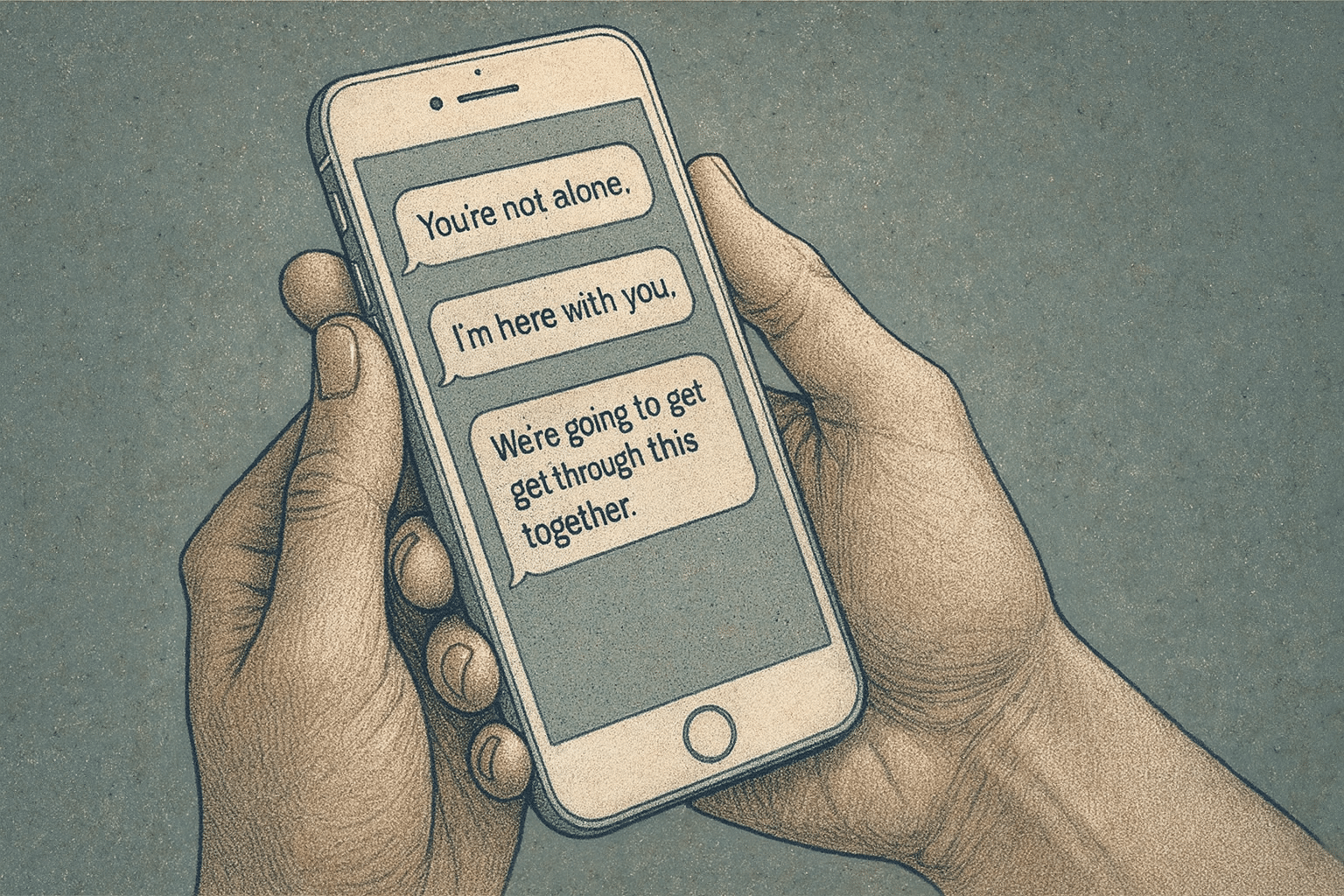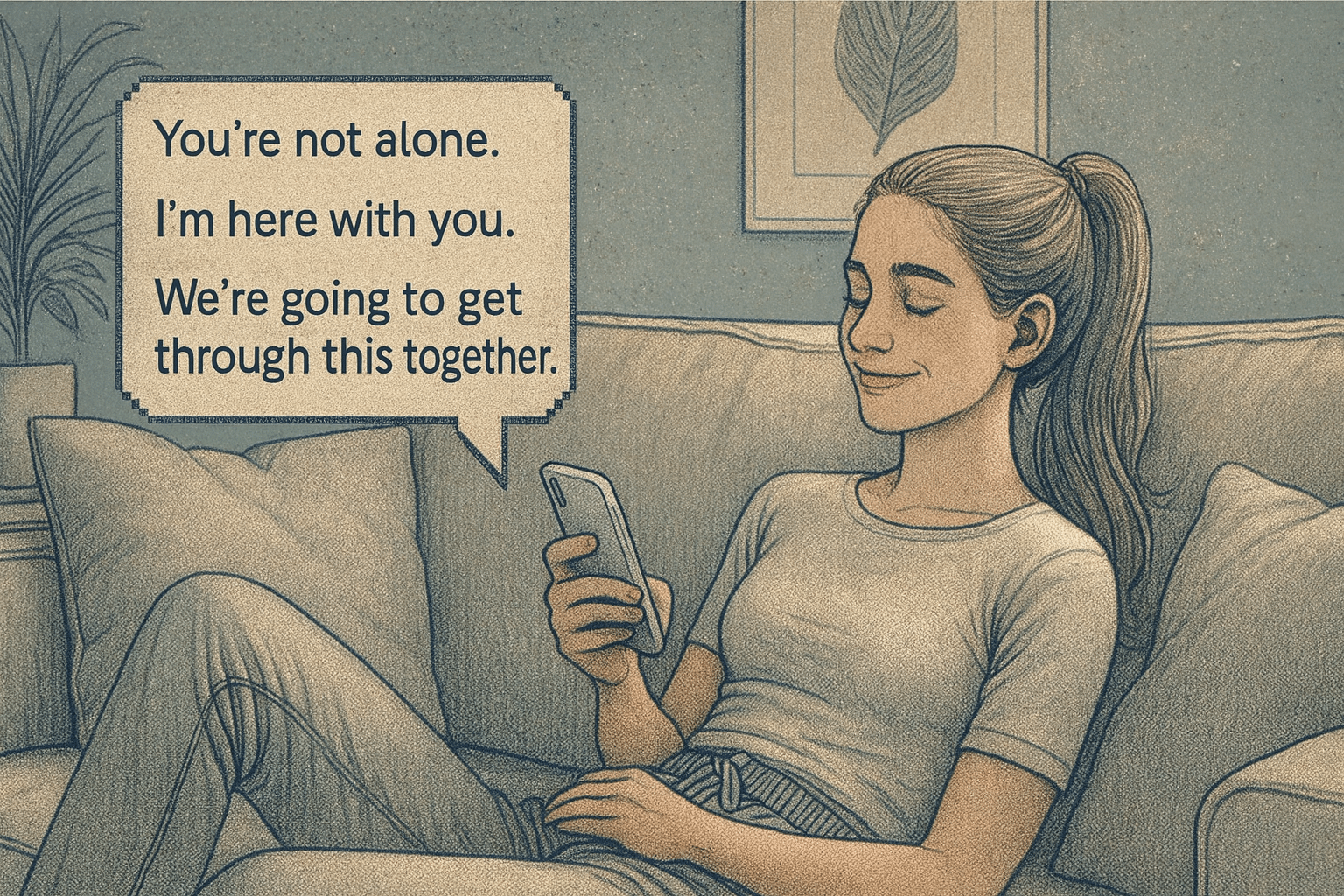Key Takeaways
- Text-based support can be highly effective during panic attacks when you use the right techniques like guided breathing exercises, 5-4-3-2-1 grounding, and calm, reassuring language.
- Your first text should be simple, non-judgmental, and focused on immediate comfort: “I’m here with you. You’re safe. This will pass.”
- Guide them through grounding techniques step-by-step via text, giving them time to respond between instructions.
- Know when text isn’t enough; if they stop responding, mention self-harm, or the attack lasts over 30 minutes, escalate to phone calls or emergency services.
- AMFM offers comprehensive anxiety and panic disorder treatment through residential, partial hospitalization, and outpatient programs designed to address underlying triggers and develop long-term coping strategies.
Understanding Panic Attacks Through Text Communication
Panic attacks can strike anywhere, anytime, and often when the person experiencing them can’t make a phone call or see you in person. When someone reaches out via text during a panic attack, they’re likely feeling intense fear, physical symptoms like rapid heartbeat or shortness of breath, and a sense of losing control. Your text responses become their lifeline to feeling grounded and safe.
Text communication during panic attacks has unique advantages. It allows the person to read and re-read comforting messages, process information at their own pace, and maintain some privacy if they’re in a public space. However, it also requires more intentional word choices since you can’t rely on tone of voice or physical presence to convey comfort.
| A Mission For Michael: Expert Mental Health Care Founded in 2010, A Mission For Michael (AMFM) offers specialized mental health care across Southern California, Minnesota, and Virginia. Our accredited facilities provide residential and outpatient programs, utilizing evidence-based therapies such as CBT, DBT, and EMDR. Our dedicated team of licensed professionals ensures every client receives the best care possible, supported by accreditations from The Joint Commission and the California Department of Health Care Services. We are committed to safety and personalized treatment plans. Start your recovery journey with AMFM today! |
Immediate Response: What to Text First
Your first message sets the tone for everything that follows. Keep it simple, warm, and immediately reassuring:
Effective first responses:
- “I’m here with you. You’re safe.”
- “This feeling will pass. I’m staying right here.”
- “You’re not alone. We’ll get through this together.”
Send this first message quickly, then give them a moment to respond. Don’t overwhelm them with multiple texts before they can process and reply. Your goal is to establish your presence and provide immediate emotional safety.

The first few texts you send can provide crucial emotional anchoring when someone feels like they’re losing control during a panic attack.
Effective Text-Based Grounding Techniques
5-4-3-2-1 Sensory Technique via Text
This popular grounding method works well through texting because it’s structured and gives their mind something specific to focus on. Guide them through it step by step:
Text: “Let’s do a grounding exercise together. First, tell me 5 things you can see around you right now.”
Wait for their response, then continue:
Text: “Great job. Now tell me 4 things you can touch or feel.”
Continue through 3 things they can hear, 2 things they can smell, and 1 thing they can taste. This technique redirects their attention from internal panic sensations to external, concrete details.
Breathing Exercises You Can Guide Remotely
Controlled breathing is one of the most effective panic attack interventions, and you can guide it through text:
Text: “Let’s breathe together. Breathe in slowly for 4 counts… 1… 2… 3… 4…”
Text: “Now hold for 4 counts… 1… 2… 3… 4…”
Text: “Breathe out slowly for 6 counts… 1… 2… 3… 4… 5… 6…”
Text: “You’re doing great. Let’s do that again.”
Send each instruction as a separate message with timing that allows them to follow along. The rhythm of your texts can help pace their breathing.
Positive Affirmation Texting
During panic attacks, the mind often spirals into catastrophic thinking. Counter this with gentle, positive affirmations:
- “This feeling is temporary and will pass.”
- “You are strong and have gotten through this before.”
- “Your body is trying to protect you, but you are actually safe right now.”
- “I believe in your ability to handle this.”
What NOT to Say: Common Text Mistakes to Avoid
Well-meaning friends and family often use phrases that can accidentally make panic attacks worse. Avoid these common mistakes:
Don’t say: “Just calm down” or “Just breathe.” Why: Implies it’s simple when it feels impossible to them
Don’t say: “What’s wrong?” or “What happened?” Why: Forces them to analyze and explain when they need to focus on coping
Don’t say: “It’s all in your head” or “You’re overreacting.” Why: Invalidates their very real physical and emotional experience
Don’t say: “Everything will be fine.” Why: Dismisses their current distress and may feel empty or false
Instead, focus on acknowledgment, presence, and simple coping instructions.

Sometimes the most helpful thing you can do is simply be present through your messages without trying to “fix” the situation.
When Text Isn’t Enough: Escalating to Phone/Professional Help
While text support can be incredibly effective, certain situations require escalating your response:
Call them or emergency services if:
- They stop responding for more than 15–20 minutes
- They mention thoughts of self-harm or suicide
- The panic attack lasts longer than 30 minutes
- They’re in an unsafe location (driving, etc.)
- They ask you to call for help
Text before calling: “I’m going to call you now because I want to make sure you’re okay.”
This gives them a heads-up and maintains the trust you’ve built through your text support.
Supporting Someone After the Panic Attack Subsides
Once the acute panic passes, your support remains important. People often feel drained, embarrassed, or vulnerable after panic attacks.
Helpful follow-up texts:
- “How are you feeling now? No pressure to respond if you need space.”
- “You handled that really well. I’m proud of you.”
- “Is there anything you need right now? Water, rest, someone to talk to?”
- “Thank you for trusting me to help you through that.”
Avoid immediately analyzing what triggered the attack or giving advice about prevention unless they specifically ask. Let them recover first.
Why Choose AMFM? Your Partner in Comprehensive Anxiety Care

AMFM’s peaceful treatment environments provide the perfect setting for learning long-term anxiety management strategies beyond crisis intervention.
While knowing how to support someone through a panic attack via text is invaluable, addressing the root causes of panic disorder requires professional intervention. At AMFM, we understand that panic attacks are just one symptom of a larger picture that deserves comprehensive, compassionate care.
Our experienced clinical teams specialize in anxiety disorders, panic attacks, PTSD, and other conditions that often occur together. We know that effective treatment goes beyond crisis management; it’s about understanding your unique triggers, developing personalized coping strategies, and building confidence in your ability to handle anxiety before it escalates.
Depending on your needs, we offer flexible treatment options. Our residential programs provide intensive, around-the-clock support in comfortable, home-like environments where you can focus entirely on healing. For those who need structure while maintaining some independence, our partial hospitalization programs offer comprehensive daily treatment with the ability to return home each evening. Our outpatient programs work well for people who want to continue their daily routines while receiving regular therapeutic support.
Treatment at AMFM goes beyond traditional talk therapy. We incorporate innovative approaches like music therapy, yoga therapy, art therapy, and other comprehensive methods that address anxiety from every angle. Our goal is to help you understand not just how to cope with panic attacks, but how to prevent them and live with greater confidence and peace.
We make starting treatment as simple as possible. We’re in-network with most major insurance plans, and our admissions team handles insurance verification quickly and thoroughly. Many of our patients find their treatment is fully covered after meeting their deductible, and we also work with private pay patients to make care accessible.
Our facilities in California, Virginia, and Washington are designed to feel welcoming and calm, not clinical or institutional. Healing happens best when you feel safe and supported, so we’ve created spaces with chef-prepared meals, comfortable common areas, and opportunities to connect with others who understand your experience.
Even after completing our programs, we remain part of your support network. We provide ongoing medication management, relapse prevention planning, family therapy, and the skills you need to maintain your progress long-term.
If you’re ready to move beyond just managing panic attacks to truly overcoming them, we’re here to help. Call 866-478-4383 or visit our website to verify your insurance coverage and begin creating a treatment plan designed specifically for you.
Frequently Asked Questions (FAQ)
Can you really help someone through a panic attack over text?
Yes, text-based support can be highly effective during panic attacks. While it can’t replace in-person comfort, texting allows you to guide grounding techniques, provide reassurance, and maintain connection when other communication isn’t possible. The key is using the right techniques and knowing when to escalate to phone calls or emergency services.
What if they stop responding to my messages?
If someone stops responding during a panic attack, wait 10–15 minutes before escalating. They may be focused on breathing or grounding techniques. If there’s still no response after 20 minutes, call them directly. If you can’t reach them by phone and you’re concerned about their safety, consider contacting emergency services or a trusted person who can check on them in person.
How long do panic attacks typically last?
Most panic attacks peak within 10 minutes and subside within 20–30 minutes. However, the person may feel drained or anxious for hours afterward. If symptoms persist beyond 30 minutes or seem to be getting worse, encourage them to seek immediate medical attention, as this could indicate a more serious medical condition.
Should I call emergency services if someone is having a panic attack?
Call emergency services if the person mentions self-harm, stops responding completely, is in an unsafe location (like driving), or if you have any doubt about their safety. While panic attacks aren’t medically dangerous, they can feel life-threatening to the person experiencing them, and professional medical evaluation can provide peace of mind.
Does insurance cover treatment at AMFM?
AMFM works with most major insurance providers and many PPO plans, which often cover treatment costs significantly after deductibles are met. Our admissions team provides free insurance verification to help you understand your coverage options before beginning treatment.






